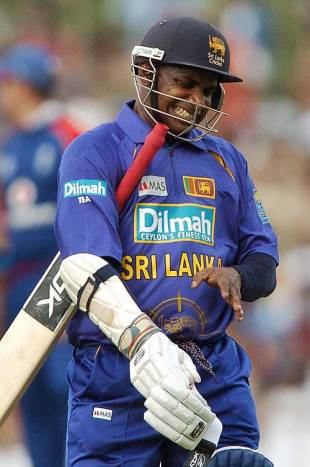One-day ducks, and carrying the bat
Most wickets without a ten-for, centuries without a boundary, and two hundreds in two days
|
|

|
The leader here is probably something of a surprise - it's Sanath Jayasuriya of Sri Lanka, who has been out for 0 no fewer than 31 times in one-day internationals. He has played 421 of them - more than anyone else - so I suppose he's had more chances. In second place is Pakistan's Wasim Akram, with 25 ducks, ahead of a further trio of Sri Lankans - Chaminda Vaas (25), Jayasuriya's long-time opening partner Romesh Kaluwitharana (24), and Muttiah Muralitharan (23). For a full list of the most ducks in ODIs, click here. You're right in saying that Courtney Walsh holds the Test record, with 43 ducks.
The expression "carry the bat" seems to date from the very early days of cricket, and used to refer to any not-out batsman, not just an opener, although that stricter interpretation was common by the early 20th century. Michael Rundell, in the Wisden Dictionary of Cricket, says the expression comes from a time when the outgoing batsman left his bat in the crease for the next man in, and so the last undefeated batsman actually did literally carry the bat off the field (dismissed batsmen were often said to have "thrown down their bat"). Coming up to date I can only recall one batsman who didn't carry a bat - Bob Willis once went out to bat in a Test for England without one, having forgotten it and left it in the dressing room.
Brett Lee is only the second man to reach 300 wickets in Test matches without ever taking ten in one - the other is the aforementioned Bob Willis, who took 325 wickets in 90 Tests but never managed more than nine in a match, which he did three times. Several other people have pointed out that Lee has never taken more than five wickets in an innings, which is unique among bowlers with more than 300 Test wickets. Andrew Flintoff, with 206 wickets and a best of 5 for 58, is next on this particular list. For a full list of Test cricket's leading wicket-takers, click here.
Yes, South Africa's 429 against Bangladesh in Centurion recently was indeed the highest Test total to include as many as five ducks. South Africa also held the previous record, with five zeroes in their 390 against England in Johannesburg in 1938-39. The overall Test record is six ducks in an innings, which has happened three times (and the highest total involved was 128, by Pakistan v West Indies in Karachi in 1980-81). For a full list of Test innings containing five or six ducks, click here.
The late Paul Hibbert made exactly 100 without a four for Victoria against the touring Indians in Melbourne in 1977-78, a feat that won him his one and only Test cap shortly afterwards, against India in Brisbane in the match you saw. Hibbert made 13 and 2, and wasn't chosen again, even though he was a consistent scorer for Victoria for several years. I only know of two other centuries that did not include a boundary: Alan Hill, who also blocked for Derbyshire, made 103 for Orange Free State against Griqualand West in Bloemfontein in 1976-77 without reaching the fence, while during Australia's 1926 tour of England, Bill Woodfull completed his century against Surrey at The Oval without hitting a four, but did hit one afterwards before he was out for 118. Wisden stated that Woodfull "observed special skill in placing the ball between short leg and mid-on, where most of his 72 singles were registered ... he hit only one four, and that, as it happened, was the last stroke he made". The highest Test score without a boundary is Geoff Boycott's 77 for England against Australia in Perth in 1978-79. His score did include one four - but it was all-run, and didn't actually reach the rope.
The answer to this is India's Vijay Hazare, who made 108 of his eventual 116 on the third day of the fourth Test against Australia in Adelaide in January 1948, then made 102 not out in the follow-on on the fourth day, eventually being out for 145 on the fifth. As I mentioned in last week's column, Hazare also bowled Don Bradman in this match, so he could hardly have done more for his side - but Bradman had scored 201, and India still lost by an innings.
Steven Lynch is the editor of the Cricinfo Guide to International Cricket (reviewed here)